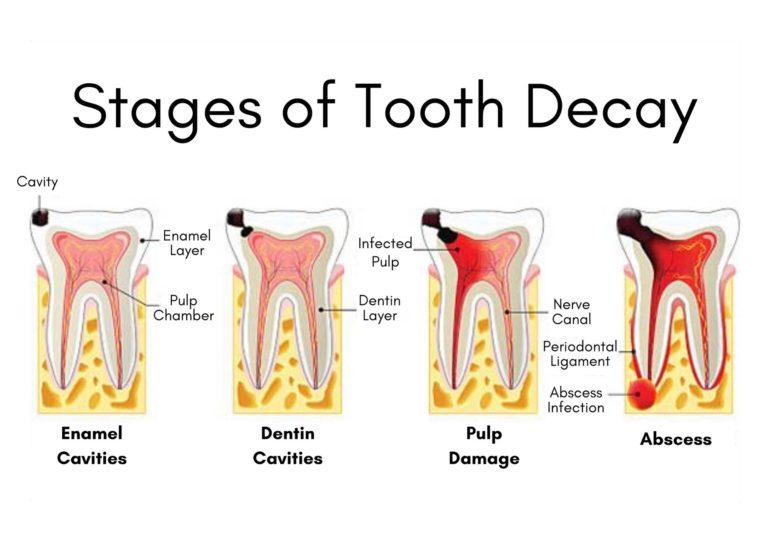A Guide To Abscess Tooth Stages
A tooth infection will occur and get worse following the abscess tooth stages. Around 1 in 5 adults have an untreated cavity that can lead to an abscessed tooth. This article will go over the abscess tooth stages and the common causes and symptoms.
Table of Contents
Abscess Tooth Stages: What is an Abscess Tooth?
A tooth abscess is a bacterial infection that occurs near the tooth. The infection will create bacteria to collect in a pocket of pus. Each infection goes through the abscess tooth stages and the symptoms and treatments are similar.
There are two types of tooth abscesses:
- Periapical Tooth Abscess: This type of tooth infection occurs in the bone at the root of the tooth. This infection will show on an x-ray as a dark spot around the tooth’s root.
- Periodontal Tooth Abscess: This type of tooth infection shows itself at the gums near the tooth. It will look appear as a fluid-filled pimple or bubble.
Both types of tooth infections can result in the loss of the tooth. It’s important to see your dentist to treat the tooth abscess and prevent any further complications. Catching the infection during any of the abscess tooth stages if very important.
Causes Of A Tooth Abscess
Tooth abscess stages can start due to a number of reasons. Many of these factors can be prevented by practicing good oral hygiene, seeing your dentist for regular check-ups, and eating a balanced diet.
The most common causes of a tooth abscess are:
- An untreated cavity that continues to grow due to bacteria in the mouth.
- A crack or a fracture in the tooth that allows bacteria to enter the tooth layers.
- Trauma to the tooth that was caused by a hard hit to the tooth.
- Untreated gum disease that starts to affect the tooth, the gums, and the surrounding bone structure.
Can an abscessed tooth be saved? That depends on the cause and severity of the infection. Only your dentist will be able to give you that answer since each case is unique to the persons specific situation.
Symptoms During Abscess Tooth Stages
If you think you have a tooth abscess, keep an eye out for the following symptoms below. As the infection grows, the symptoms can worsen and increase the chance of losing your tooth. The most common symptoms of a tooth abscess are:
- Swelling near the tooth creating a sense of pressure
- Gums that are red and puffy
- Tooth pain that doesn’t go away and may occur randomly
- A pimple or bubble near the gumline
- A bad taste or odor in the mouth
In more severe cases, possible symptoms are:
- A fever
- Trouble breathing and swallowing
- Swollen lymph nodes
- Swelling of the airway
Stages Of Tooth Abscess
The stages of tooth absscess are as follows:

- Incipient Decay: This is when the cavity is just starting to grow through the outer layer of the tooth. At this stage, there is a chance of remineralizing to stop the cavity progression.
- Enamel Decay: At this stage, the infected portion is mostly through the enamel or the outermost layer of the tooth. The cavity will need to be treated but may not need any anesthesia at the dentist.
- Dentin Decay: The cavities in between teeth have now reached the second layer of the tooth, the dentin. The cavity can spread faster through this layer because it is softer than enamel. All chances of can you reverse cavities are not possible at this stage.
- Pulpitis: The pulp is the home of the nerve and blood vessels. At this stage, the infected portion of the tooth has reached the innermost layer. Pain and pressure are most likely present from the infection.
- Abscess: The infection has spread all the way down to the root. At this stage, an antibiotic is most likely needed. A root canal or extracting the tooth is the best treatment plan to resolve the infection.
Can an Abscessed Tooth Make Your Sick?
An untreated infection of your tooth can absolutely make you sick as it progresses through the abscess tooth stages. The infection will continue to get worse and your body will try to fight it just like any other infection.
In severe cases, a bad tooth infection can be fatal. If you think you are experiencing any of the abscess tooth stages, consult your dentist as soon as possible. Don’t wait to experience the worst symptoms to seek proper help.
Can An Abscessed Tooth Be Saved?

In most cases, an abscessed tooth can be saved. Depending on the causes of the infection and how long it was left untreated, your dentist will do their best to save the tooth. To save the tooth, your dentist will test it by:
- Radiographically by taking an x-ray
- A percussion test, tapping on the tooth to test the vibrations reaching the nerve.
- Electric Pulp Test uses a small electrical current to test the nerve reaction.
- Thermal testing involves using hot or cold stimuli to test the nerve reaction.
In most cases, a root canal or an extraction will be needed to treat the tooth abscess. Your dentist may prescribe an antibiotic before treating it.
- For more information, check out our Tooth Extraction Guide.
Abscessed Tooth Stages - Catching It Early
In order to save the tooth after an abscess occurs, catching it early is the most important factor. An untreated tooth abscess will cause the infection to spread and create more damage to the tooth, bone, and gums. Infections can spread and start to affect multiple teeth if ignored.
Contact your dental team today if you think you have an abscess. A tooth infection is serious and can be fatal in severe cases. The faster the infection is treated, the more likelihood the tooth can be saved.
Frequently Asked Questions
How quickly does a tooth abscess progress?
A tooth abscess forms over time and rarely occurs suddenly. The infection can take up to a few months to show any symptoms. As the infection progresses through the abscess tooth stages, it’s important to let your dental team know early to prevent losing a tooth.
How do I know if my tooth abscess is spreading?
If you have a tooth abscess, the infection will continue to grow and worsen when left untreated. Signs that your abscess is spreading are increased pain that radiates outside the mouth down the neck, swelling and pressure involving multiple teeth, and pain that increases. Contact your dentist right away if you present with any of these symptoms.
Take Home Smile Store
Visit our Take Home Smile store for educational brochures and other fun printables to help with oral hygiene. All products can be customized to fit your dental needs.



